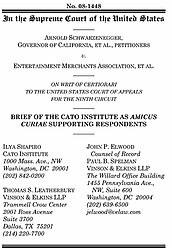Learn more about Cato’s Amicus Briefs Program.
“These kids today and their violent [blank].…” This refrain has been around for as long as there have been kids — and elders to shake their fists at them. In the 19th century, dime novels and “penny dreadfuls” were blamed for social ills and juvenile delinquency. In the 1950s, psychologist Fredric Wertham’s attack on comic books — in his bluntly titled book Seduction of the Innocent — so ignited the national ire that Congress held hearings on the cartoon menace. In response, the comic book industry voluntarily adopted a ratings system. Similarly, backlash against the movie industry and the music industry (e.g., Tipper Gore’s attack on gangsta rap) caused those respective industries to also adopt voluntary ratings systems. And the videogame industry too adopted an effective and responsive ratings system after congressional hearings in the early ’90s. Thinking this ratings system ineffective, however, California passed a violent videogame law, which prohibits minors from purchasing games that are deemed “deviant,” “patently offensive,” and lacking in artistic or literary merit. The gaming industry challenged the California law and the Ninth Circuit struck it down on First Amendment grounds. California now seeks to overturn the lower court’s ruling by arguing that violent videogames deserve an exemption from First Amendment protection. Cato’s brief highlights not only the oft-repeated and oft-overblown stories of the “seduction of the innocent,” but the less-repeated stories of the effectiveness and preferability of industry self-regulation. We show that not only does self-regulation avoid touchy First Amendment issues but that entertainment industries take self-regulation very seriously. Moreover, evidence from the Federal Trade Commission shows that the existing videogame ratings system works more effectively than any other regulatory method. Adding a level of governmental control, even if were constitutional, would be counterproductive.

This work is licensed under a Creative Commons Attribution-NonCommercial-ShareAlike 4.0 International License.

